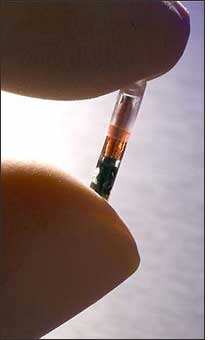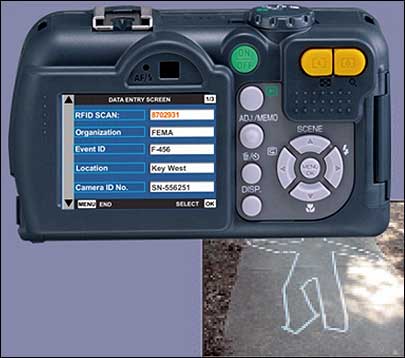In the aftermath of Hurricane Katrina—which devastated much of the north-central Gulf Coast in 2005—Gary Hargrove, the coroner of Harrison County in southern Mississippi, used RFID tags to track human bones unearthed after the flooding. Marc Poulshock, VP of implantable and emergency management divisions for RFID solutions provider VeriChip, says Hargrove duct-taped a tag to each bone. According to Poulshock, Hargrove utilized VeriChip’s VeriTrace platform, designed to help identify and track the remains of deceased individuals—particularly during large-scale disasters with hundreds or thousands of fatalities.
VeriChip is better known for its VeriMed product, in which embedded tags are used to retrieve a living person’s medical history. In its third-quarter financial results, VeriChip reported that its implantable segment, which includes VeriMed and VeriTrace, generated $53,000, primarily through sales of its VeriTrace products. (VeriChip also sells RFID patient-tracking systems for health-care facilities that do not use implantable tags.)
This is the first revenue posted by the division since its initial public offering, announced in February, and beats the company’s earlier projections that it would not generate revenue until next year. (The company used to market its implantable tags as part of an access-control system called VeriGuard, but has since discontinued that product, choosing instead to focus only on health-care and forensic applications, according to Allison Tomek, VeriChip’s VP of investor relations and corporate communications.)
The VeriTrace system garnered interest after being used to help the Federal Emergency Management Agency (FEMA) Disaster Mortuary Operational Response Teams (DMORT) identify and track the remains of those who died as a result of Hurricane Katrina. Since then, the Georgia Bureau of Investigation, the Hawaii Department of Health, the Florida Emergency Mortuary Operations Response System (FEMORS) and the medical examiner’s office in the Department of Heath in Erie County, New York, have all purchased the system.
Of these, the Erie County purchase is the largest, involving more than 2,000 VeriChip implantable passive RFID tags, along with three handheld interrogators and three Ricoh Pro G3 digital cameras, to document the remains. The tags operate at 134 kHz and conform to the ISO 11784 and 11785 standards.
“Different states have different organizations that handle disaster preparedness functions,” says Poulshock, explaining why VeriTrace purchases have been made from a variety of state organizations. They are also variously funded, he adds. The Georgia Bureau of Investigations acquired the VeriTrace product as part of a government emergency preparedness grant, for instance, while Hawaii used funds secured to prepare for a pandemic flu outbreak.
Each deceased individual is injected with a VeriTrace RFID tag. In cases of dismemberment, severed body parts are tagged individually. The system is designed for disaster recovery, but Poulshock says it could also be employed for general morgue purposes, as a replacement for the manual, toe-tag tracking system widely used at present.
Once attached, a handheld interrogator is used to read the 16-digit unique ID number encoded to the tag. The reader then transmits this ID, via a wireless Bluetooth communications link, to the Ricoh digital camera. The interrogator emits an audio alert—a short beep—upon receiving a tag read, and the camera also emits a beep once it receives the ID. Recovery personnel can then use the camera to photograph the remains or evidence, and the ID will be associated with each subsequent image stored in the camera’s memory, along with the GPS coordinates of the camera, which incorporates an onboard GPS receiver.
Once the reader collects the next tag ID and transmits it to the camera, the previous ID is overwritten, the camera’s operating system associates the new ID with all subsequent images. After the scene is completely surveyed, the camera can be linked to a computer via a USB port, and all images and associated tag and GPS data can be saved to a VeriTrace database, or to the user’s own data-collection system.
Rodney Wall, special agent in charge of the Georgia Bureau of Investigation’s office in Greenville, Ga., was responsible for purchasing the VeriTrace system used at that location. According to Wall, the system performed well during an exercise the agency performed last spring, in which it mocked up a disaster with more than 50 fatalities. “We had a problem with one of the cameras,” he says. “The GPS unit did not function properly, but we have since replaced that. Otherwise, it seemed to work very well.”
In addition, Wall’s team was able to use the GPS data gather to document the recovery sites on the Web-based Google Maps application. He says the agency’s VeriTrace deployment—consisting of 500 tags, five interrogators, five cameras and VeriTrace software—cost roughly $13,500.



